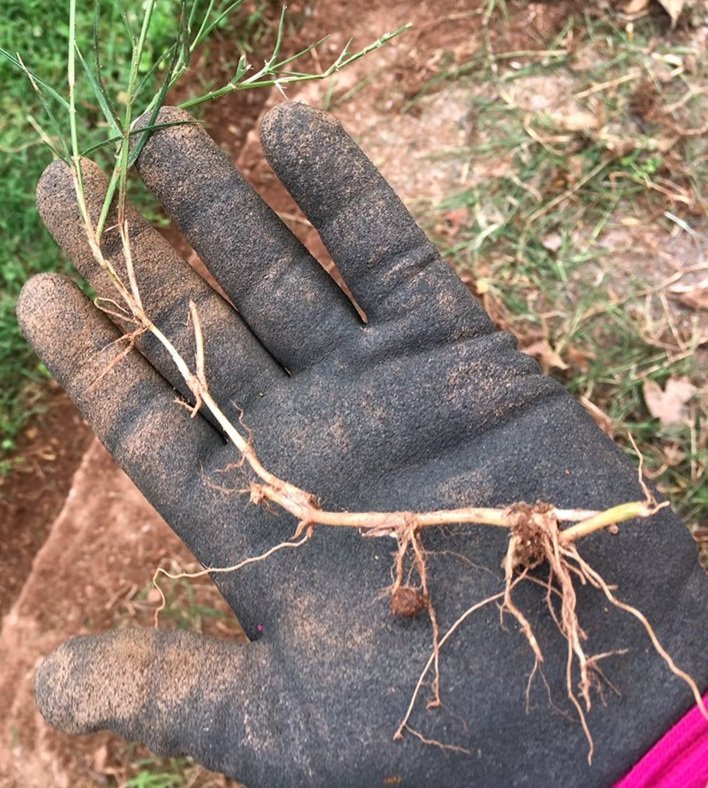Ask OGS: Eradicating Bermuda Grass from Your Garden
Dear OGS,
I have Bermuda grass in my yard, and it is getting into my garden beds. NOTHING I have tried has worked to get rid of it. What do you suggest?.
Thanks,
Joan
Flat Rock, NC
———
Dear Joan,
This question is close to my heart. I bought a house a couple of years ago, and the yard is filled with Bermuda grass that the former owner must have purposely seeded into the lawn. For me, Bermuda grass presents a mind-boggling obstacle to pleasurable gardening. Bermuda grass laughs at your thorough weeding job and respects no boundaries. It quickly and ceaselessly overtakes your garden beds without regard for your prospective harvest. Once you have planted, it is nearly impossible to weed it out without destroying your veggies and flowers.
Bermuda grass rhizome - photo by Ruth Gonzalez for OGS
Gardener Alert!
Adjectives in my research described Bermuda grass as evil and tenacious with roots that “go to China.” Texas garden designer Liz Klein likened it to “tiny running bamboo.” It is very devious and sneaks its way into your yard by growing in difficult-to-reach spots—alongside the foundation of your house, mixed into the iris bulbs, and along rock borders. It rebounds at an astonishing rate and grows straight across your paved driveway without missing a beat. I have re-weeded areas multiple times, digging down as deep as I could, looking for rhizomes, and the grass returned and spread like wildfire, even growing vertically into small shrubs. I have edged my driveway to find 3-foot-long stolons leaping across the pavement 30 days later.
Best Solution to Eliminate Bermuda Grass
Prevent the grass from achieving photosynthesis by covering it with a barrier. Plain mulch is not adequate to suppress Bermuda grass. I used sheet mulching in my yard effectively with the long-term plan of doing my entire yard over time.
Although Bermuda grass (Cynodon dactylon) is considered an excellent pasture grass, it is a gardener’s nightmare. This highly invasive grass originated in the eastern hemisphere, was once promoted by the USDA as a high-value forage crop and lawngrass, and is now prevalent in the southeastern and southwestern USA. Bermuda grass is also called wiregrass, couch grass, and devil’s grass (a very appropriate nickname!). It reproduces in three ways—by seed, by above-ground vine-like shoots (stolons), and by below-ground shoots (rhizomes). Seeds remain viable in the ground for a couple of years. It is tough to kill even with multiple applications of strong herbicides.
Materials Needed
Compost
Cardboard
Sod Staples
Mulch
Steps to Follow
Bermuda grass in garden bed - photo by Ruth Gonzalez for OGS
Mow or (better yet) weed-eat the grass area as low as possible, ideally to the ground. Then rake up and remove any grass/rhizomes/stolons.
Lay down a half-inch layer of compost over the entire area. This will stimulate biological activity.
Flatten cardboard boxes and leave them together to be two layers thick. Appliance boxes are ideal.
Lay cardboard over the entire area, overlapping box edges at least 6 inches so there is no place for grass to grow through.
Secure cardboard with generous Sod Staples to help prevent grass penetration.
Thoroughly wet cardboard all the way through—this is important.
Cover the area with 3 inches of mulch.
Do NOT allow Bermuda grass to grow on top of mulch. Weed-eat it back.
Do NOT cut holes in cardboard for planting, as that will be where the Bermuda grass could take hold.
If a seedling pops up, weed it out quickly.
Allow 4–6 months or more before disturbing the area.
During this process, consider removing the existing plants to a temporary bed in already planted areas. Otherwise, Bermuda grass will likely thrive at the base of the existing plants and re-invade your garden bed.
Other Thoughts
Bermuda grass stolons growing over pavement - photo by Ruth Gonzalez for OGS
Be extremely vigilant. Learn what Bermuda grass looks like, and do not import any plant material into your yard that contains even a hint of Bermuda grass. It’s not worth it.
Edge and weed-eat regularly to keep the Bermuda grass confined to the lawn and OUT of your garden beds. If the grass is not yet in your beds, this can be a very effective remedy if done religiously.
Do not rototill the area. You will break the rhizomes into small pieces to create more plants.
One application of RoundUp (or other herbicide) + ground cloth is not a viable long-term solution. Vinegar-based sprays and organic herbicides like BurnOut may temporarily suppress Bermuda grass.
If you already have Bermuda grass, be aware that eradication is an ongoing and probably a multi-year challenge (Matt Martin, using a powerful herbicide, considered it a 3–4 year endeavor).
YouTube gardener EcoTechnify found old carpets beneficial for suppressing Bermuda grass. He lifted the edges twice yearly to keep the grass from growing over the top.
When the grass is most actively growing in the summer heat, solarize the area using UV-clear plastic, adding 2 feet to the site on all sides for good measure. Allow 6 weeks to work.
When digging out Bermuda grass rhizomes, Gardener David Stillwell put the soil through a screen to capture smaller rhizomes.
Do NOT add any part of Bermuda grass to your compost pile or leave it in your yard. It needs zero encouragement to re-take your yard.
Before applying to your garden, manures should be composted to the proper heat to kill any Bermuda grass seeds.
Check out the University of California’s Integrated Pest Management Information.
Readers, if you have a solution that has proved effective for at least one year, please share! And Joan, we sincerely wish you great success with this job.
Thanks for writing,
OGS
This blog post, written and copyrighted by Ruth Gonzalez, was originally published as part of a previous Organic Growers School article series called "Ask Ruth," which addressed the gardening concerns of home growers. Some updates may have been made by OGS staff to keep the content current.



